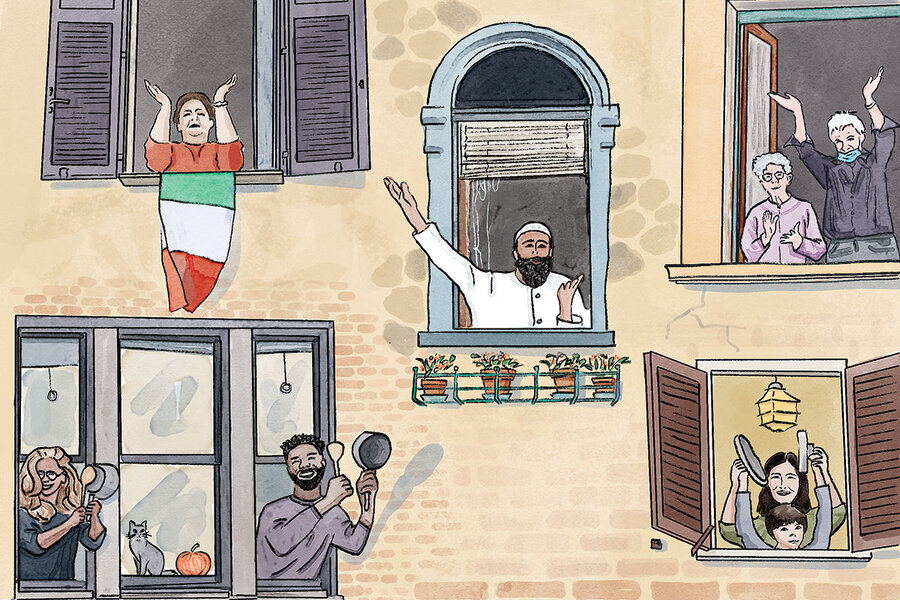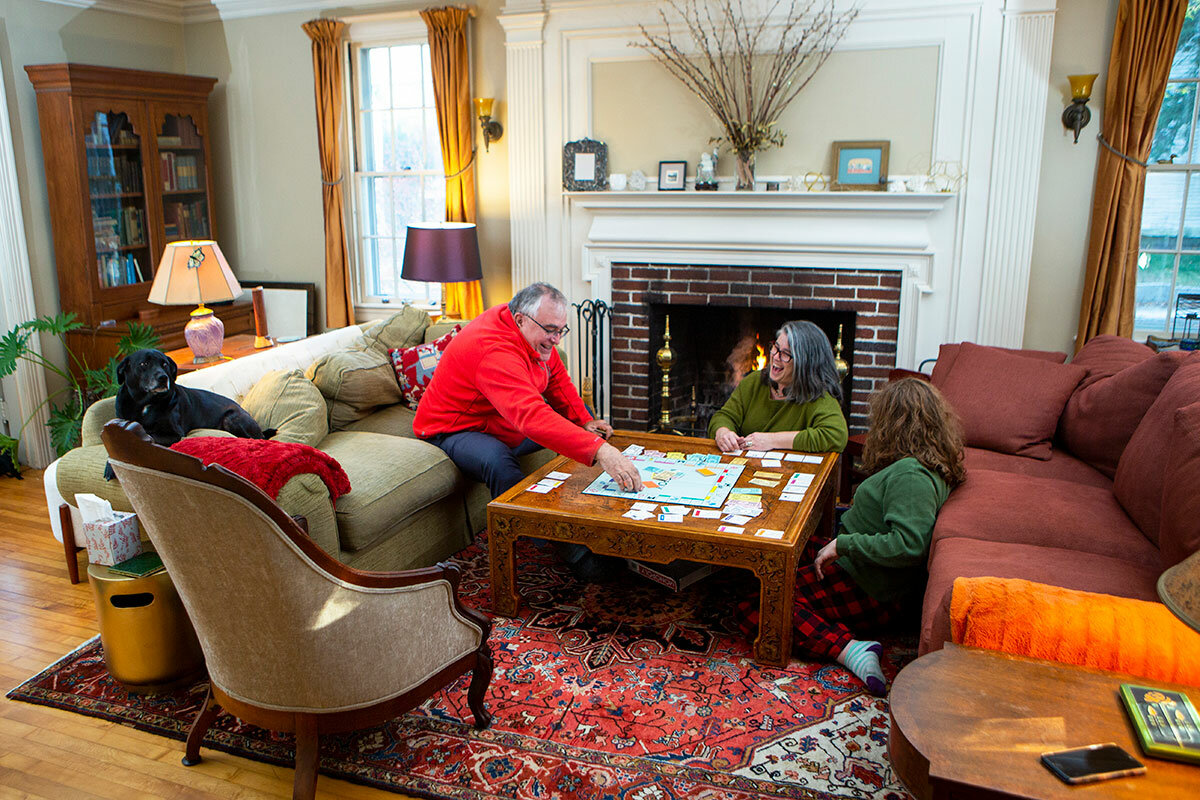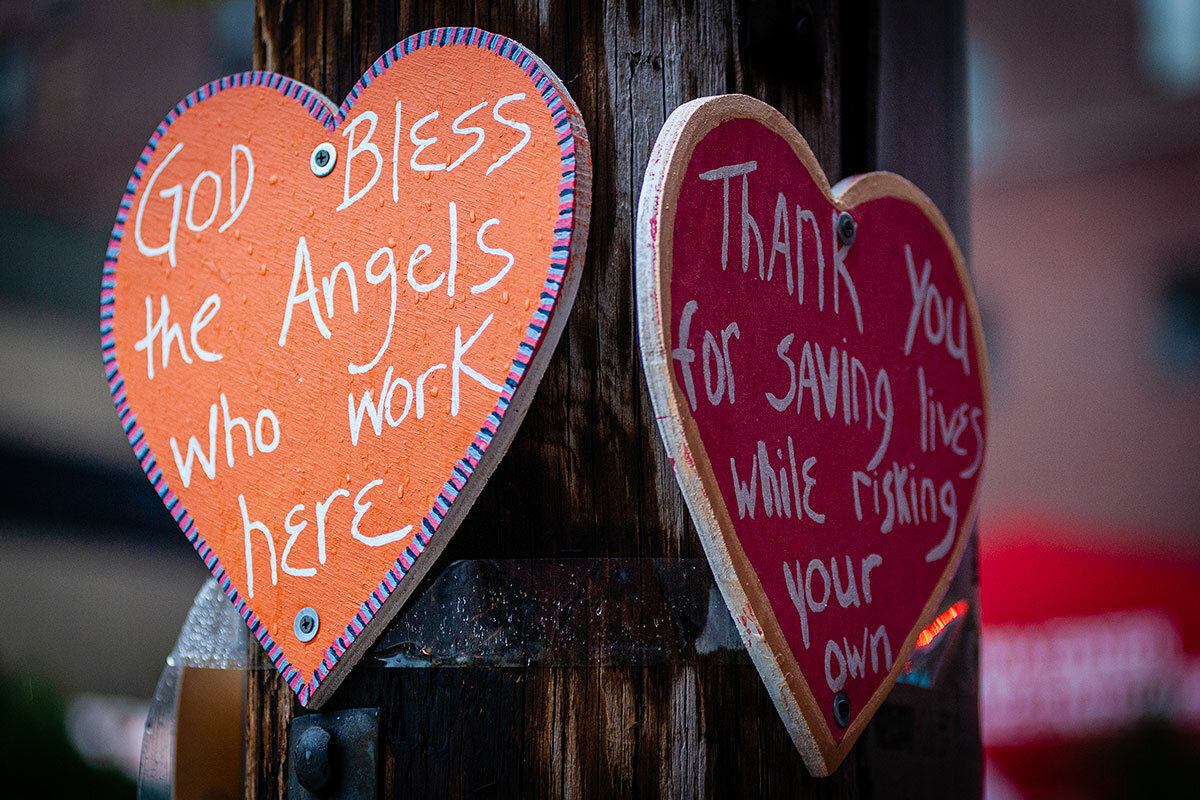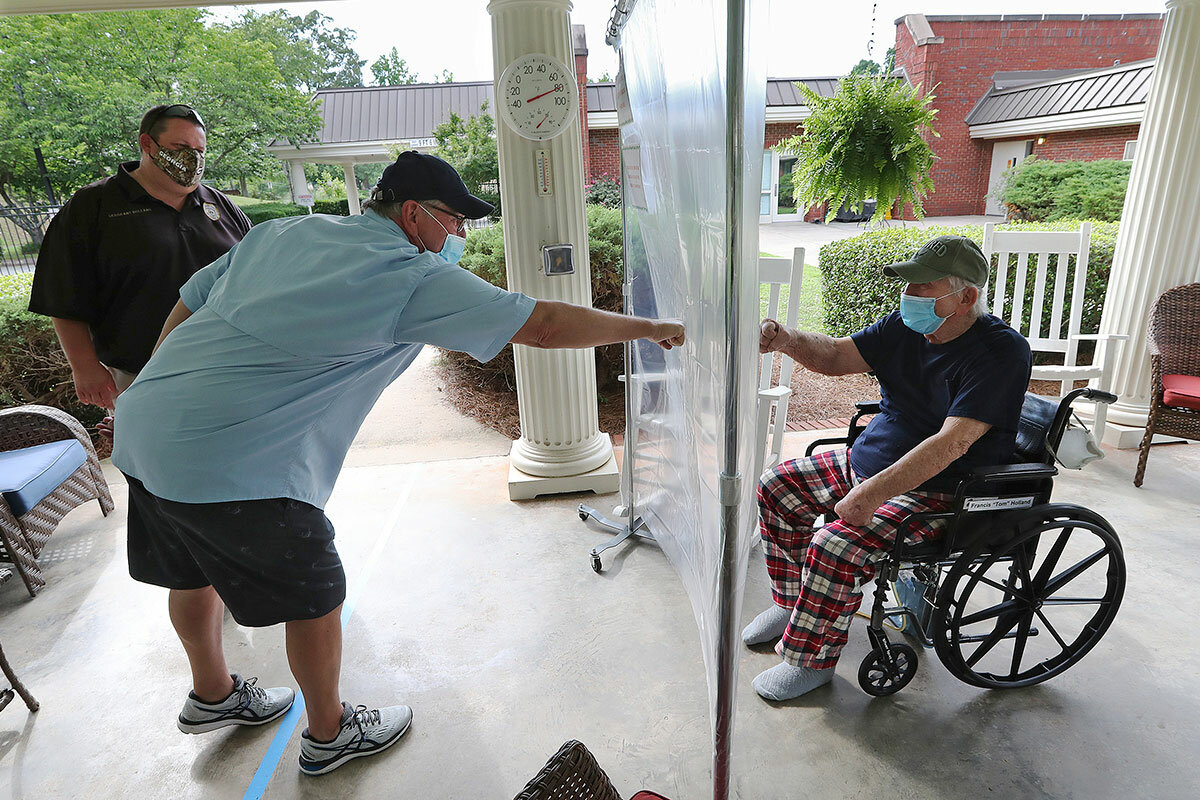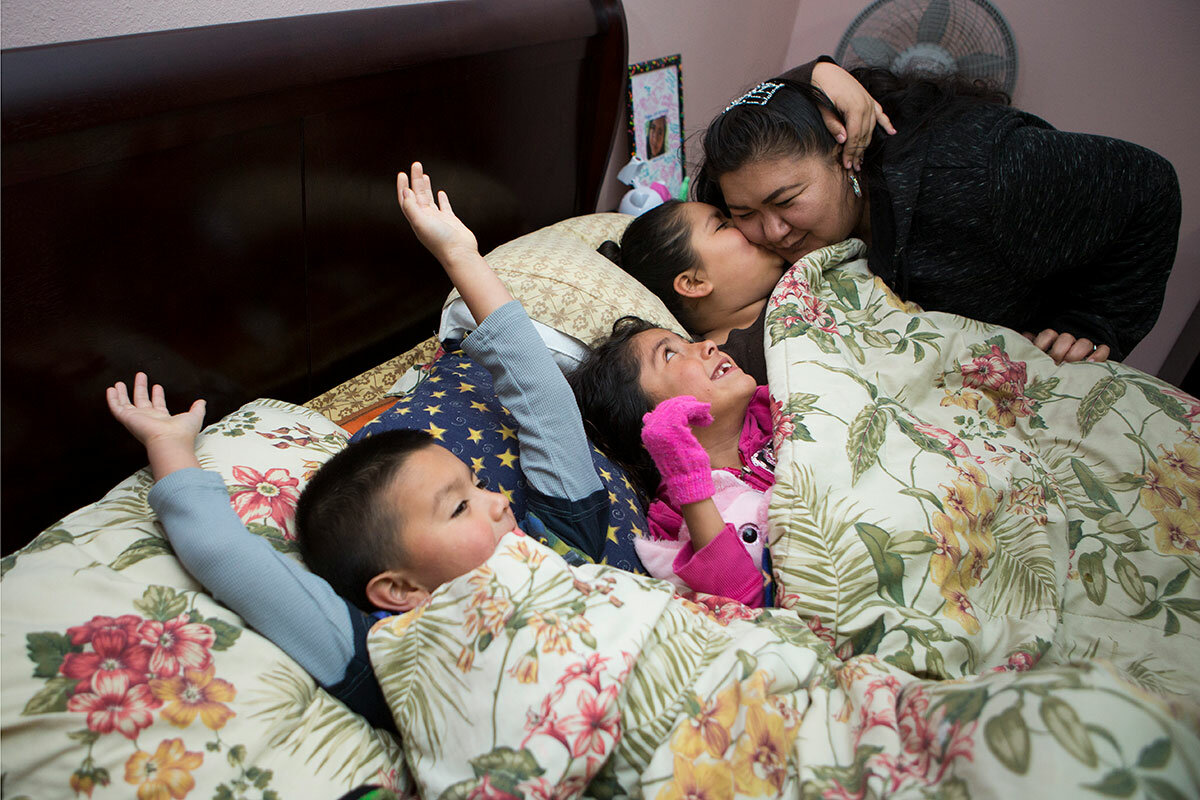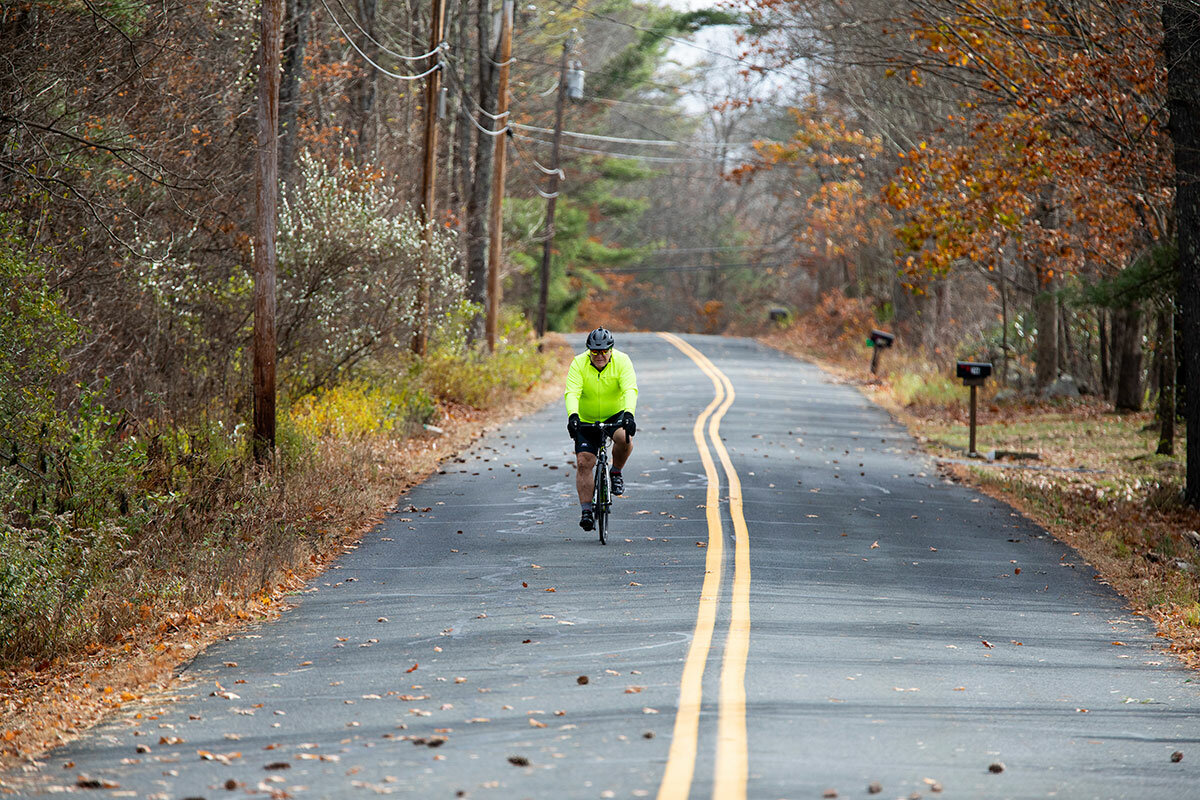A Thanksgiving like no other: Finding uplift in a dark year
Loading...
| Keene, N.H.
In the 1980s, Andrew Oram, fresh from college, won a small fellowship enabling him to build his own bicycle and then pedal it across Europe. He carried a camera; he took pictures. Until one day when he found himself along the rolling coast of what was then Yugoslavia – near Rab maybe, or Split, he’s no longer sure.
Like always, he grinded the uphills, flew the downs, and spun the twisty flats. The usual, except that on this day the sunlight was unlike any he’d seen, the turquoise sea so clear that floating skiffs seemed to rest on air. On this day, he found himself in the most beautiful place he’d ever been.
He reached for his camera.
Why We Wrote This
Expressing gratitude can be a balm for individuals and society in times of hardship. Research shows that people who give thanks feel better, as well as report higher levels of enthusiasm, attentiveness, and energy.
“And suddenly I said to myself, ‘Andy, are you really seeing what’s in front of you? Or are you taking a picture of it so you can show people at home?’
“I realized some part of what I was doing – had been doing the whole trip – was interfering with my seeing, my being in the moment. ‘When’s the next time you’ll be on the Dalmatian Coast?’ I asked myself.” (Answer to date: never.)
He put the camera down. And that evening, when he reached town, he mailed it home. He rode on without it.
Why is Mr. Oram, a longtime friend of mine, telling us this story now, when asked about Thanksgiving at a time when a lot of Americans are finding it harder than usual to be thankful?
He pauses, says nothing for a spell. He lives in Keene, New Hampshire, now with his wife and daughter. He works as a personal finance coach. Outside the leaves have fallen, the soil turned hard. His small city has seen few COVID-19 cases yet has suffered like most communities from store closures and Zoom schooling and people doing jobs at makeshift bedroom desks if they still have jobs at all.
“It’s work for me to stay in the moment,” he says. “It takes work to constantly appreciate and enjoy what’s in front of you. It takes attention. And attention is not free.
“Gratitude is the same way.
“Especially this year.”
2020, our “annus horribilis”
We hardly need reminding about this year. But for the record we’ll run the checklist anyway: COVID-19, wildfires, social injustice, lockdowns, layoffs, economic distress, hurricanes, street violence, politics turned tribal.
Not the best of times.
But was it the worst? Before 2020 was even half gone, headlines had begun either asking that question or asserting the answer. By July Fourth, the T-shirts had arrived. Since then, the media speculations, themed apparel, and Twitter memes have only proliferated – 2020, our annus horribilis.
Researchers captured the sentiment. Algorithms monitoring our collective psyche at the University of Vermont’s Hedonometer project determined that May 29 – four days after George Floyd’s death – was the “saddest day” in the project’s 12-year history. In July, the COVID Response Tracking Study, conducted by the nonpartisan research organization at the University of Chicago, found that the year 2020 was unfolding as the “unhappiest in 50 years.” A subsequent NORC survey fielded in September revealed that Americans’ expectations for their children’s futures were at their lowest ebb ever.
Fair enough, then. A person could be forgiven for feeling more than a little blue. And for feeling, as well, that an abiding sense of gratitude on this particular Thanksgiving may be elusive to achieve.
Of course, as many historians have taken pains to remind us, 2020 is not the worst year ever. There have been some bad ones! The year 1919, for instance. That was when the Spanish flu was still on its way to killing half a million Americans and 50 million people worldwide. Inflation skyrocketed and unemployment shot to 20%. Race riots and massive labor strikes racked the country.
Or consider 1863, when half the country was a war zone and 51,000 soldiers were killed or wounded at Gettysburg. Or, more proximately, 1968, which saw 100,000 Americans and 200,000 Vietnamese killed or wounded in Vietnam, the My Lai massacre, two assassinations, and riots that burned cities.
None of which compares to 1348, when the Black Death was killing a third of Europe’s population (among attempted remedies: walk barefoot while self-flagellating).
But the truly worst of the worst? That would be 536, when an Icelandic volcano released so much ash that Europe, the Middle East, and parts of Asia were darkened for two years. Global temperatures plummeted, crops failed, famine spread. Not long after, bubonic plague caused the loss of as many as 100 million people. They were called the Dark Ages for a reason.
The lesson, say historians: We humans have been through some stuff – and still, here we are.
Behavioral scientists tell us that viewing history unsentimentally will help curb our “nostalgia bias,” and enable us to reframe the present as better than we thought – and as more than worthy of being thankful for.
But perhaps that’s off-target. Whether the litany of anni horribili beyond our living memories provides us perspective or not, it may not matter. Our current times feel plenty bad. And perhaps, just perhaps, that’s when gratitude is most potent.
A salve during moments of great affliction
Truth is, this year has seen plenty of gratitude, instinctively and generously expressed. The people applauding out their windows for emergency responders, the heart signs, the food deliveries to essential workers, the neighborhood trash teams, the looking-in on elders. Online platforms as purpose-built as gratefulness.org and as customarily combative as Twitter have been flooded with counted blessings: for our loved ones, for the Amazon carrier, for our dogs.
People gave thanks for simple things, mostly – their families, video chats, the “tall green trees that are older than me,” a hummingbird, the ocean, soup. (“Yep, soup,” says a West Sacramento, California, man.) But many, many other expressions of gratitude took the form of generosity, of trying to give back or pay it forward. The news was filled with stories of people in grocery lines paying for the customer coming next, donations to farmworkers, businesses furnishing free meals to front-line responders.
In New York, Sauce Pizzeria provided up to 400 free pizzas a day to hospital staff. When Sauce’s landlord found out, he gave the pizzeria three months of free rent and $20,000 to underwrite more pies. In Cambridge, Massachusetts, orchestra conductor Benjamin Zander staged free concerts in his driveway, the music made by players who had otherwise been silenced by the darkening of performance venues. Hundreds of people, masked and distanced, fanned out down the street to listen.
Gratitude has always been a salve during moments of great affliction. In the early 1940s, at the nadir of World War II for the U.S. abroad and at home, radio was the cultural lifeline that convened the nation. The most-listened-to broadcasts were the famed fireside chats by President Franklin Delano Roosevelt. The second most popular programs were by Harry Emerson Fosdick.
Mr. Fosdick was a renowned theologian. By the 1940s, he’d founded and led the massive, nondenominational Riverside Church in New York City for a decade and a half, and Americans could listen to his radio show weekly. Three million did.
“This is a ghastly time to be alive,” he said in one of his best-loved wartime sermons. “Nevertheless it is also a great time to be alive” – a time calling for “wisdom and courage to face and create momentous change,” and for “realistic appraisal of our false reliances.” Hard times are a blessing, Mr. Fosdick argued, because they make it urgent that we become the best version of ourselves, and that we separate what matters in our lives from what doesn’t.
So it has always been, this idea of hardship as a whetstone for which thanks are due. It’s easy to forget that the official Thanksgiving holiday we know today did not even exist until Abraham Lincoln created it during that hardest of national hardships, the Civil War. On Oct. 3, 1863 – just weeks before he would go to Gettysburg to give his famous address – he issued a proclamation that thanks “should be solemnly, reverently and gratefully acknowledged as with one heart and one voice by the whole American People,” and that it should be done on the last Thursday of each November.
The proclamation didn’t quail from noting that the country was, indeed, “in the midst of a civil war of unequaled magnitude and severity.” And it humbly suggested that any prayers offered up might particularly “commend to His tender care all those who have become widows, orphans, mourners or sufferers.” Nevertheless, the president observed, it still was a time of peace overseas, of bounty in the fields and mines, of lawfulness in the villages.
According to Arthur Brooks, who teaches a course on happiness at Harvard Business School, “Psychologists have found that many of the most meaningful experiences in life are quite painful.”
Yet the question still remains: Can people feel grateful under dire circumstances? “My response is that not only will a grateful attitude help – it is essential,” writes Robert Emmons, the University of California, Davis psychologist in “The Gratitude Project.” “It is precisely under crisis conditions when we have the most to gain by a grateful perspective on life. In the face of demoralization, gratitude has the power to energize. In the face of brokenness, gratitude has the power to heal. In the face of despair, gratitude has the power to bring hope.”
Of course, none of that alters the reality that hard times are, well, hard. Back in New Hampshire, Mr. Oram expresses the view of many we interviewed across the country: “It’s so easy to fall into a despairing outlook [right now]. The fragility of what we have feels greater. The stakes, with all we face today, make gratefulness so much harder to find.
“But the sense that there’s real skin in the game – real potential for loss – is important. Sometimes, maybe, actually experiencing loss is what has to happen to wake us up.”
“We’re bonded like never before”
The city of Donna, Texas, is 2,000 miles from Keene, New Hampshire, and has suffered a year about as statistically distant. Per capita, Donna and neighboring towns in the Rio Grande Valley have seen 18 times as many COVID-19 cases as has the Keene area – and 60 times as many deaths. Michelle Salazar, a third grade teacher, wife, and mother of three, has been holding classes remotely in Donna since the first lockdowns of spring, like many places in the United States.
Then, in July, Hurricane Hanna hit.
“We didn’t have electricity in my house for four days,” says Ms. Salazar. “But that was nothing. Now that I’ve returned to school I’ve found that a lot of my [students’] parents are living with their in-laws or with their friends because either their roof was blown off or their house was flooded, and they ended up with relatives, and the relatives had COVID so they all got COVID.”
Still, Ms. Salazar knows some things about gratitude intuitively, just as most of us do. She just may be better than most at expressing it. “Even though all this is going on, I am very grateful,” she says. “I always see the good in the bad. I think that’s always helped me in my life.” Ms. Salazar spent her childhood as a third-generation migrant farmworker. But she made her way through schools wherever she was, scratched out a college degree, created a family, built a life. “In a way the pandemic is a blessing in disguise because it broke our routine,” she says now of her days in Donna. “It was: off to work early, drop-offs, pickups, home at 7, cook, eat, showers, bedtimes. Now, though, we’re here, together, even if we’re working or learning in separate rooms. In the afternoons my kids and I are outside, we play kickball, we feed the dogs and ducks. Then we cook together, and eat. When they go to bed I go back to work, until 10 or midnight. The hours are long, but we’ve had the afternoon. And we’re bonded like never before.”
Research consistently shows that people who give thanks feel better. A seminal and representative experiment in the gratitude canon required three groups to keep diaries: One set of participants could record experiences of any kind, another set was asked to record only “hassles,” and the last set was asked to jot down only “gratitude-inducing” experiences. UC Davis’ Dr. Emmons, widely recognized as the field’s leading thinker, summarized the findings: The people in the gratitude-recording group “felt better about their lives as a whole,” exercised more, made more progress toward important personal goals, and reported higher levels of “alertness, enthusiasm, determination, attentiveness, and energy.” They were more likely to have helped someone with a personal problem or offered emotional support. Experiment after experiment has delivered similar results.
Religious leaders, too, underscore the beneficial role of gratitude when circumstances seem bleak. “Gratitude grounds you, and reminds you of reality,” said the Rev. James Martin, a Jesuit priest, in a recorded conversation with Christianity historian Diana Butler Bass in July. “It’s not honest when you focus on the one thing really annoying you, instead of on the totality of your life,” which daily includes moments of grace. Even the deep sadness caused by tragic events such as Mr. Floyd’s death and its illumination of social injustice can coexist with a feeling of gratitude, said Ms. Bass. “That my heart hurts, and that I can see this problem – I have gratitude for those things. That my heart is still tender and that my vision can be widened to see a different way of being human” is worth being thankful for.
An expectation to be grateful
Polls say we’re not ready for Thanksgiving this year. Or: We’re ready, but we’re not expecting much. Only 27% of people will celebrate as they normally would, according to a CivicScience survey. A survey by Ipsos found that two-thirds of people worry that travel will risk their health. More than half plan to celebrate only with immediate family – and these surveys were fielded before the recent spike in U.S. coronavirus cases. A Wall Street Journal article on Oct. 27 reported plans in some households for outdoor heaters, rented tents, spaced tables. People fervently adapting.
So, how do we find gratitude amid all the sacrifices?
Ms. Salazar tells this story: “Every fall back at school I get stressed out and tell my husband, ‘I wanna quit!’ ‘Nah,’ he says, ‘you’re just saying that. You love what you do. You get like this at the same time every year.’ And I’m like, ‘No, seriously, I wanna quit!’
“Well this year since school started I haven’t been stressed. That’s surprising. I don’t feel stressed because this year I look at life and think: I can’t change the pandemic, I can’t change the online learning. My co-teachers are all stressed out and venting. But I tell them, no, I won’t complain, it is what it is. I can’t change it. And I’m not going to stress out about something that I can’t change. I feel less stress than I used to. That really surprises me.
“And I’m thankful for it.”
Ms. Salazar has internalized what Harvard’s Dr. Brooks advises when he says, “[Don’t let] your disappointment interfere with what you can affect and the choices you can make today. [And] resolve that while you don’t know what will happen next week or next month, you do know that you are alive and well right now, and refuse to waste the gift of this day.”
Here’s Dr. Emmons again, summarizing two decades of research: “A key determining factor of well-being is the ability to notice, appreciate, and savor the elements of one’s life.”
Which is, up in Keene, what Mr. Oram tries to recommit himself to each morning.
“I list the things I’m thankful for, and I’m pretty specific. I used to do it at night but the morning is better – it sets an expectation to be grateful. It’s a kind of prayer, but not exactly. It involves no asking, no requests.
“I’m acknowledging a gift.” The gifts? His family, the home they’ve made, a friend who greeted him in the street, a bike ride.
The November cold in New Hampshire sinks in early and hard, and the pine hills are no kin to that Dalmatian coastline of his long-past European trip. But Mr. Oram gets on his bike anyway and pedals. Through the quiet town, out on the rural lanes, in the chill that deepens with the shade of the trees. Then the road tilts up, and he climbs. At the crest, there’s a clearing and then Surry Mountain Dam, braced by hills, the road atop it flat and straight as an airstrip.
“I always stop there, not long, but I stop. I look. Very consciously. I’ve climbed, and it’s beautiful.
“I know that later in my ‘prayer,’ if that’s what it is, I will be back here. It will be the memory of a feeling. There won’t be words but if there were, I’d be acknowledging that my life was tangibly better because I felt this at the top of Surry dam.
“So often when we have those experiences we have them once and then not again. I guess what I’m saying is that I’m trying to reexperience the wonderfulness of life. Gratitude for me comes in having experienced – and maybe even reexperienced – something special, a moment when I felt fully alive.”
Possibly this is not so complicated, he’s saying. Even this year. Especially this year.
So Mr. Oram climbs, and stops, and looks, and stores a sensation that he knows no travail can take away. He prepares a moment for which he’ll later give thanks.
And then he rides back down.




